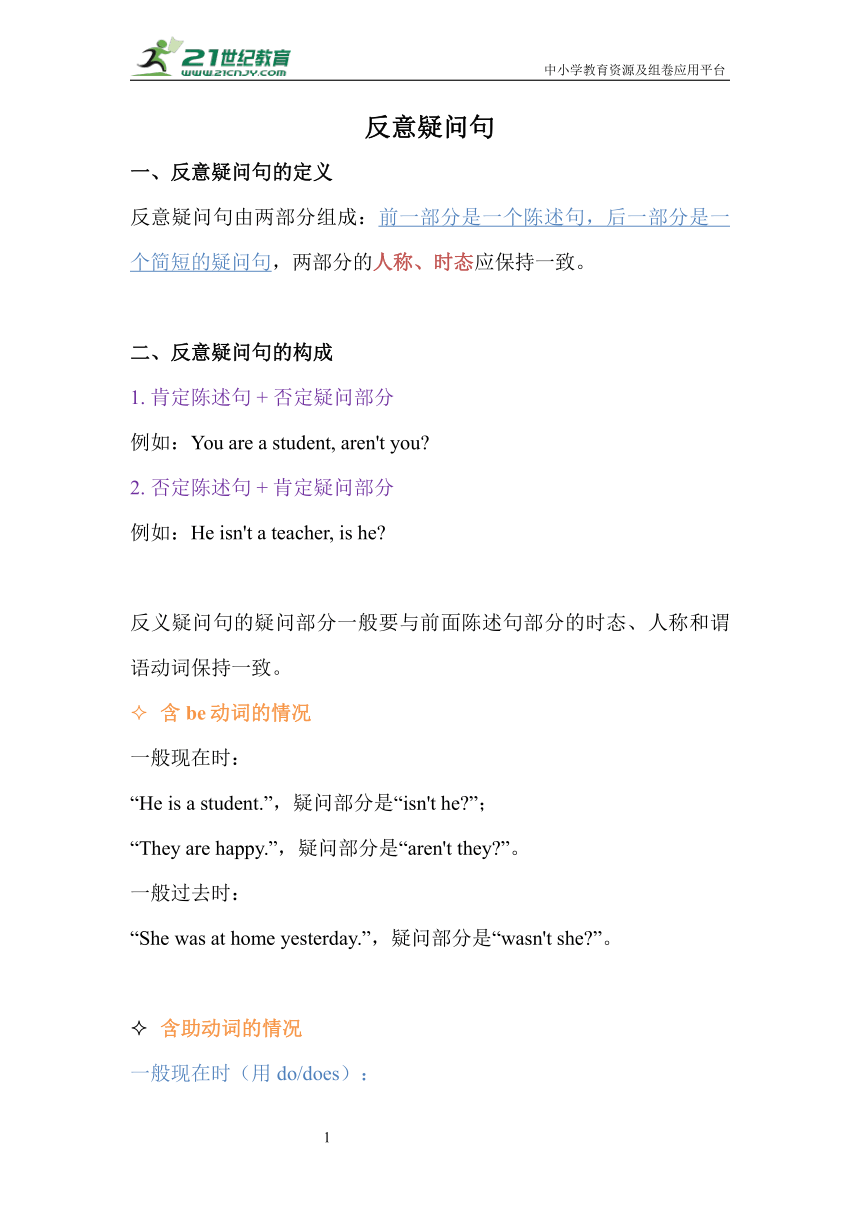
中小学教育资源及组卷应用平台 反意疑问句 一、反意疑问句的定义 反意疑问句由两部分组成:前一部分是一个陈述句,后一部分是一个简短的疑问句,两部分的人称、时态应保持一致。 二、反意疑问句的构成 1. 肯定陈述句 + 否定疑问部分 例如:You are a student, aren't you 2. 否定陈述句 + 肯定疑问部分 例如:He isn't a teacher, is he 反义疑问句的疑问部分一般要与前面陈述句部分的时态、人称和谓语动词保持一致。 含be动词的情况 一般现在时: “He is a student.”,疑问部分是“isn't he ”; “They are happy.”,疑问部分是“aren't they ”。 一般过去时: “She was at home yesterday.”,疑问部分是“wasn't she ”。 含助动词的情况 一般现在时(用do/does): “He does his homework every day.”,疑问部分是“doesn't he ”; “They do sports in the morning.”,疑问部分是“don't they ”。 一般过去时(用did): “She did her best in the exam.”,疑问部分是“didn't she ”。 现在完成时(用have/has): “He has been to Beijing.”,疑问部分是“hasn't he ”; “They have finished the work.”,疑问部分是“haven't they ”。 过去完成时(用had): “She had left when I arrived.”,疑问部分是“hadn't she ”。 含情态动词的情况 例如,“He can swim.”,疑问部分是“can't he ”; “They should help others.”,疑问部分是“shouldn't they ”。 三、反意疑问句的回答 1. 依据事实回答 - 反义疑问句回答的基本规律是按照事实来回答。如果事实是肯定的,就用“Yes”回答;如果事实是否定的,就用“No”回答。例如:“You are a student, aren't you ”如果是学生,就回答“Yes, I am.”;如果不是学生,就回答“No, I'm not.”。 2. 翻译注意事项 - 特别要注意的是,在反义疑问句的回答中,中英文的逻辑可能会有差异。 中文里“是”和“不是”主要是针对前面陈述句部分进行判断,而英语中的“Yes”和“No”是针对后面的疑问部分来回答的。 比如对于“He doesn't like math, does he ”如果他确实不喜欢数学,英语回答是“Yes, he doesn't like math.”(注意这里Yes翻译成“是”,但在逻辑上和中文习惯不太一样);如果他喜欢数学,就回答“No, he likes math.”。不过更自然的英语回答是直接说“Yes, he does.”(他喜欢)或者“No, he doesn't.”(他不喜欢)。 四、反意疑问句的特殊情况 1. 当陈述句中含有 never、few、little、nothing、nobody、no one 等表示否定意义的词时,疑问部分要用肯定形式。 例如:He has never been to Beijing, has he There is little water in the bottle, is there 2. 当陈述句的主语是 this/that/these/those 时,疑问部分的主语用 it 或 they。 例如:This is a book, isn't it Those are apples, aren't they 3. 当陈述句的主语是everyone、everybody、someone、somebody等时,疑问部分的主语一般用they。例如“Everybody likes music, don't they ”。 当主语是everything、anything、nothing等时,疑问部分的主语一般用it。 例如“Everything is ready, isn't it ”。 4. 当陈述句是 there be 句型时,疑问部分用 be there 的相应形式。 例如:There is a book on the desk, isn't there There are some students in the classroom, aren't there 5. 当陈述句的谓语动词是 have/has/had to(不得不)时,疑问部分用助动词 do/does/did。 例如:She has to go home now, doesn't she They had to finish the work yesterday, didn't they 6. 当陈述句的谓语动词是 have/has/had(表示“有”)时,疑问部分可以用 have/has/had 的相应形式, ... ...
~~ 您好,已阅读到文档的结尾了 ~~